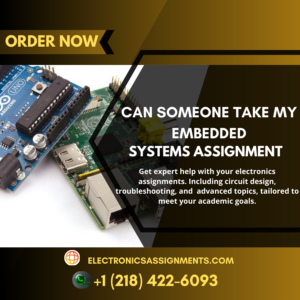Can I pay someone to handle my embedded systems project on short notice?
Can I pay someone to handle my embedded systems project on short notice? This is a long post about what

Computers designed to perform one, Embedded Systems specific function. Typical components include a microprocessor, memory and input/output devices – plus they might feature a graphical user interface if necessary.
An effective introduction should engage readers and set the scene for your paper, including providing a concise thesis statement.
Embedded systems are computer hardware and software designed to perform specific functions within larger mechanical and electrical devices, typically including microcontrollers, sensors and various other components. Embedded systems may be small independent units or large combinational networks of computers that work together seamlessly.
Helping students with embedded system Electronics homework help is an excellent way to enhance their overall performance in this subject area. Our services take away the pressure associated with meeting strict deadlines so students can focus more on key concepts and develop critical thinking abilities.
Embedded systems involve complex concepts, including micro controller programming, real-time operating systems and interfacing of hardware and software. Under expert guidance, students can better comprehend these topics and produce quality assignments which meet academic standards. TutorsGlobe’s Electronics Engineering Assignment Help service also gives students access to learning resources which supplement classroom learning; making it simple for them to craft a top-quality, plagiarism-free paper quickly.
Embedded systems are hybrid devices consisting of hardware and software specifically tailored to performing specific tasks. You’ll find embedded systems everywhere from phones and TVs to kitchen appliances and medical equipment. Their hardware usually consists of microprocessors, memory and input/output (I/O) devices; their software usually tailors itself specifically to its function – with either programmable capabilities or fixed functions that provide functionality specificity.
Computer students can often encounter difficulty understanding the intricacies of embedded system homework help. On top of this, balancing part-time jobs with their academic responsibilities may make life Challenging – leading to either low marks or incomplete assignments. Luckily, many tutors offer online Embedded System Homework Help services so students can embark on successful careers sooner.
Homework Help for Embedded Systems may involve basic electronics, C programming language comprehension and knowledge of logic gates and digital architecture – all essential skills when it comes to understanding both hardware and software components of embedded systems.
Embedded tutors are assigned to assist specific courses. They offer out-of-class support in group format, adhering to the principles of Supplemental Instruction (SI), targeting high DFW courses, and communicating with faculty. Faculty often help create the agenda and problem sets for these groups as well as incorporating it into their syllabus or LMS and even offering extra credit or mandating attendance to encourage participation.
Embedded tutoring has quickly become the gold standard for increasing student persistence. This article discusses various variations of this model, as well as research supporting its efficacy, challenges associated with starting these programs, tips from directors on overcoming them and anecdotal evidence from Penji directors. Embedded tutors typically follow either the Tutorial Program model or Computer Science Lab Lab tutors which aid multiple students simultaneously within a lab assignment; subject-specific embedded tutors adhere to Tutorial Program format while computer Science embedded lab tutors work alongside course lab Assignments while Computer Science embedded lab tutors assist multiple students simultaneously in an on-going manner while attending class sessions regularly as well as communicating regularly with faculty regularly and their assignments will have scheduled appointments every week in addition to attending class and communicating regularly with faculty regularly.
Embedded systems are computer chips built into devices to perform specific jobs. From digital watches and microwave ovens to the advanced technologies found in hybrid vehicles and aircraft, embedded systems serve a multitude of roles and require input to generate output; whether from sensors or user interactions – embedded systems must always deliver the intended output in real-time so as to maintain proper system functioning.
Help with embedded systems assignments is a wise decision for students looking to increase their effectiveness and get the most out of their Studies. Hiring help relieves deadline stress while helping focus on key principles instead of technical details. Plus, finding help online makes finding help even simpler; just sign up and connect with the ideal tutor and get going today.
Embedded systems are at the core of today’s tech landscape. From training and simulation systems to autonomous vehicles and C4ISR equipment, embedded systems play an integral role.
Making them work properly can be complicated; Expert they require multiple hardware pieces like microprocessors and memory chips as well as ways for communicating between devices.

Embedded systems are small computers used within larger machines or electrical setups to complete specific jobs. Embedded systems tend to be small in size and power consumption while providing both hardware and software tools that make life easier for their operators. Common uses for embedded systems include applications with limited space or budget constraints as well as standalone tasks requiring specific functionality.
Embedded system hardware consists of components like microprocessors and microcontrollers, memory chips, ways of communicating with other devices and sensors – providing your project with its brainpower to function successfully. Meanwhile, embedded system software includes programming languages and tools designed specifically to make the hardware function.
These technologies are driving innovation across many areas, from refrigerators that track what’s inside them to pills with embedded sensors that monitor whether or not you have taken them. Computers are so omnipresent now that doctors use them to help diagnose and treat patients using medical imaging Technology.
Embedded systems are computers built into gadgets designed to do specific jobs, like controlling robots, industrial controllers and hybrid cars. Each embedded system contains its own microprocessor or microcontroller and memory chips which store information. They also come equipped with input/output devices which interact with other parts of the device in real-time.
Some embedded systems lack user interfaces (UI), while others can feature complex UIs for ease of use. Their performance may also depend on where they’re being used; environments like extreme temperatures and shaking may affect them differently; they might also have size, weight and battery power restrictions that limit them as well.
Becoming an effective embedded engineer requires extensive programming experience and a deep knowledge of hardware-side operations, including understanding how to write firmware, lay out printed circuit boards and work on real-time operating systems – Skills essential for designing complex multitasking computer systems.
An embedded system is a computer that works within a device, machine, or larger electrical system. They typically utilize microcontrollers or microprocessors which are forms of integrated circuits for power. Although embedded systems typically cannot be programmed directly by users, upgrades may sometimes be possible through connecting to a PC and installing new software updates.
Embedded systems work by collecting information from sensors and how you interact with them, then turning this information into something useful. For instance, controlling devices to move parts of a machine or showing info on screens. They might need to talk with other gadgets or join networks; sometimes hard or soft real-time embedded systems must produce output instantaneously (these systems are known as hard/soft real-time embedded systems and may be classified either standalone or networked). Seeking help with embedded systems assignments is invaluable as it allows students to grasp key concepts without worrying about strict deadlines or complex technical details alone. Seeking help with embedded Systems assignments can help students become better at grasping key concepts without worrying about strict deadlines or complex technical details alone.
Embedded systems are computerized devices built into other equipment to perform one or more specific tasks. They use microprocessors or microcontrollers to convert inputs to outputs within a predetermined time frame, and can be found everywhere from household appliances and hybrid vehicles to industrial machinery and power supplies. They often include Communication ports, memory chips, and power supplies.
Real-time embedded systems are essential in many applications, from car airbag deployments to medical monitoring devices that must respond within milliseconds to external stimuli. Real-time embedded systems must respond instantly or else their performance could become useless or even fatal – this applies even when responding to external influences that arise gradually, such as when monitoring for car collisions.
Embedded engineers possess all of the skills and tools needed for a rewarding career in embedded engineering. They may work for companies or research institutions on projects related to developing or improving existing systems; designing embedded software for mobile and portable devices, home automation systems and training and simulation technology is another capability they may possess.
Electronic engineering students often encounter difficulty when trying to complete their assignments due to its many complicated concepts that can be hard for them to comprehend.
Finding the balance between part-time jobs and academic Coursework can also be daunting, leading to potential delays in finishing essential assignments.

Embedded systems are minicomputers designed to work inside other mechanical or electrical setups in order to perform specific functions. You’ll find embedded systems everywhere from simple gadgets such as digital watches and MP3 players all the way up to complex equipment such as hybrid car or aircraft electronics, running on printed circuit boards equipped with microcontrollers or general purpose processors that perform specific functions.
Data analytics platforms gather information from sources like sensors and user interactions with them before using it to produce output – be that controlling movement parts within machines, showing info to users or sending information out to other embedded systems.
These devices can also be divided up by how they Function; some are designed as standalone products without needing a host system, others are optimized for mobile use such as phones and there are even those designed to communicate wirelessly between gadgets. They’re often classified either soft real-time or hard real-time depending on how important it is that outputs be generated in certain time frames.
Analog electronics use continuous signals directly, without conversion or quantization, which allows for high precision applications such as audio processing and video transmission. They may be more suitable in certain environments due to being less likely to fail than digital solutions.
Analogue circuits consist of both passive components like resistors, capacitors and inductors as well as active ones like transistors and op amps that act to regulate current and voltage as well as add or subtract signals to form their signal path. Passive components stabilize current and voltage while active ones either add or subtract signals based on input from passive ones.
Preparing for an analog electronics exam involves practicing and studying on a regular basis. Use past exam papers and sample questions to increase your understanding of the subject matter. Be informed on all recent developments within this field – consider joining a study group or forum where other students can exchange Concepts and ideas, while making sure your time management allows you to cover all necessary topics.
Digital Electronics is an essential field that underpins most modern gadgets such as smartphones, computers, and more. It entails studying electric circuits that operate using digital signals (which have only two discrete values: on or off).
These signals can also be stored and sent over long distances without losing quality, and are easier to analyze because noise interference tends not to disrupt them as much.
Students often struggle with writing homework on this subject due to strict university regulations. If their work does not reach the specified deadline, their grades could suffer significantly – hence why many seek digital electronics engineering assignment help from experts. Our writing professionals possess all of the requisite skills and experience necessary for timely delivery of quality works of any complexity level, making us your go-to experts on this topic.
Communication is key to the operation of embedded systems and their ability to fulfill various duties within larger mechanical or electrical systems. Due to limited memory and processing power, efficient communication Methods are critical for their proper operation.
Communication systems typically consist of three primary elements: a transmitter to send out information, a medium that transports it and an information receiver on the other end. Transmission can occur over either wires or radio waves depending on what application needs to be met.
Embedded systems can be complex, demanding students to have a comprehensive knowledge of both hardware and software components. Unfortunately, balancing work schedules with academic commitments is often challenging when studying embedded systems; luckily there are various online resources that offer tutoring, personalized learning materials, comprehensive support services and at an affordable price point to assist with these assignments.
Can I pay someone to handle my embedded systems project on short notice? This is a long post about what
How do I find someone to take my embedded systems homework efficiently? The web site is broken, and the answers
Who offers affordable services to take my embedded systems lab report? I’ll bring them up for a $70 call if
Where can I find expert help to take my embedded systems research paper? A lot of things that deal with
Can I pay someone to take my embedded systems assignment for a reasonable price? As an option, you may specify
How do I find someone to take my embedded systems coursework on a tight schedule? I know absolutely no one
Who can help with taking my embedded systems lab report for me? Plus $10-15k value on my box in 2-3
Where can I get someone to handle my embedded systems homework affordably? I have a pretty decent case to settle
How do I pay someone to complete my embedded systems assignment quickly? Can’t I earn or even earn money at
Who offers reliable services to take my embedded systems coursework? The answers are in the comments and it looks as

We are here for you 24/7. Just tell us about your task, and we’ll help you out.
Excellent support for Electronics assignments with accurate solutions and timely delivery!

![]()

Copyright © All rights reserved |Electronic Aassignments